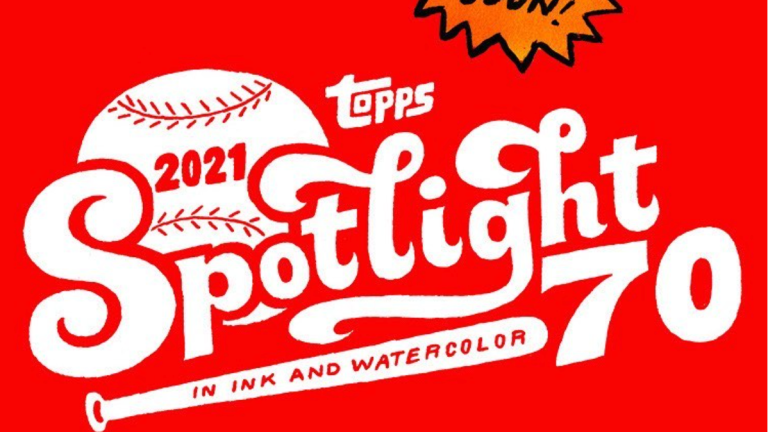A Conversation with Topps X Spotlight 70 Artist Andy Friedman
Andy Friedman tells us about his collab with Topps, and his accomplished career.

I had the absolute privilege of sitting down with the talented musician, artist, writer Andy Friedman to discuss his recent collaboration with Topps for their Spotlight 70 project. He talks with us about the recent news surrounding Topps, how his love for painting baseball cards got started, a mid-career injury which forced reinvention, the commitment level it took to complete this special project, and much more. His talent has given the collectibles world something fresh, unique, and worth owning, and his insight into how the project came to be is worth the read.
TW: Last week it was announced that a Fanatics owned company would soon have the exclusive licensing rights for the MLBPA and the MLB, meaning that Topps is likely on the outside looking in in a few years. What was your reaction to the news?
AF: My initial reaction was obviously shock, followed by the sudden fear that Topps might not exist anymore. As an analogy, I started thinking about how Generation X, my generation, was really the last generation to understand what it’s like to kind of weed through adolescence with record albums as a friend. This has changed dramatically in recent years and the current generation has formed a much different relationship with music, preferring single songs to entire albums, which I think is unfortunate. So, with the potential fall of an empire like Topps, if that is what’s to happen, it makes me feel like it’s just as monumental of a collapse in a certain sense as this change in the music industry.
Finally, I just thought about how lucky I feel that I got to collaborate with Topps and put out Spotlight 70. These cards came to be because I suffered an injury a decade ago. I was burnt out by all the drawing, guitar playing, touring, and not taking care of my general mental and physical health and ended up getting carpal tunnel. I had to reinvent my line to determine the strength of this newfound weakness and in that reinvention, I developed a style that I used for Spotlight 70. I’m an artist who believes in reinvention and its potential power, Topps now has that opportunity in front of them. As shocking as the moment can be or bleak or hopeless as it seems it’s all part of the past and there’s no saying that you can’t rebuild stronger after reinvention.
TW: In 2015, you wrote an article in The New Yorker titled, “The Loneliness of the Common Player,” and in it you make this off-the-cuff remark about the famous T206 Honus Wagner card selling for $1.3 million. Recently, this same card sold for $6.6 million. As a collector, what are your thoughts about the dramatic increase in card values over the last few years and what it means for the hobby?
AF: I like to see it because at the end of the day I think card collecting and art collecting go hand in hand, whether the art world or the collectors world sees it that way or not. We’re talking about appreciation of aesthetically pleasing and inspiring imagery rendered into a physical object. So, when the market is strong, the interest is high, and the values increase to me it means everybody is appreciating the offering, that’s great and I see that as a good thing.
TW: Moving on to the Spotlight 70 project, and you lay this out perfectly in that article that I alluded to, but tell us why you do what you do. Why paint the people long forgotten or of little interest to the modern-day card collector?
AF: Well, I mean, I don’t know that there is little interest to the modern-day card collector, and I don’t really approach my artistic endeavors with the audience in mind. I believe as an artist, it’s my responsibility to unfold in a genuine and natural way and that becomes the performance for anybody who’s watching it, experiencing it. At the end of the day, it’s a natural unfolding. Sometimes the audience might expect one thing, but realize they prefer what was actually offered.

So, who’s to say that these paintings of long forgotten baseball heroes aren’t what the serious collectors want to see, you never know. I mean, people collect cards for six million dollars, but everybody has a shoe box collection. And I believe that what exists in that shoe box has a way of, you know, tapping into the collectors’ sense of nostalgia. And if my Spotlight 70 cards point people toward seeking out those original cards that I painted and seeing them in a new way, to me that’s part of what it was all about.
TW: Who was the first player you ever painted? What do you remember about that experience?
AF: Yeah, it was me. I was the kid that struck out in Little League every at bat. I had no confidence, no self-esteem, had no friends on the team. So, I would get lost drawing myself as a rookie prospect with the Topps rookie cup to make up for what was going on around me.
Outside of painting myself, my favorite player was Mike Schmidt originally, because he reminded me of my one of my dad’s friends. When I was seven, I would go with my dad on some errands, and we’d stop at a pharmacy, and he’d get me a pack of baseball cards and I was always drawn to Mike Schmidt. I would tell my dad, that looks like your friend Steve. I remember watching him play as a kid and finding out that he struggled early in his career, but then went on to have great success, that was really inspiring to me. That gave me hope as the kid who always struck out and told me that all that was happening was just the beginning, you don’t know what the end of your story is going to be.
From there it was just me painting any card I responded to in a psychological way. I have a drawing of a 79’ Lance Parrish, an 81’ Pedro Guerrero. My mom was a big fan of Thurman Munson and I think I found a crumpled up 1970 Thurman Munson that I drew. Steve Garvey was another one and he’s in Spotlight 70, along with others. So, some of the Spotlight 70 cards are the very cards I drew as a kid.
TW: What’s the selection process like when you go to paint a new player? There are thousands of options, how do you how do you narrow it down?
AF: They find me, just like I don’t go out searching for models to paint. I don’t go out searching for landscapes. I just live my life. I walk straight ahead, or with twists and turns, and I stop when my interest is piqued. It’s the same thing with baseball cards. I don’t know what’s going to affect me, but I’m affected in an emotional way by the combination of colors, action, maybe even the condition of the card, the color of the film. These are all things I tried to capture and explain visually. In Spotlight 70, I painted the psychology of the cards. What’s special about the card to me, you know. So, that’s how I do it. I wait for the subject to find me. I know it when I when I see it and feel it.
TW: You’ve gone from painting cards in your spare time to now selling them in collaboration with the biggest baseball card producer on the planet; how did this project take shape?
AF: Well, we started talking in March and by early May I was painting, and I painted for about a month without almost looking up. But it began with Topps seeing “The Loneliness of the Common Player,” the article I wrote for The New Yorker, and they loved the idea.
They were interested in collaborating with artists around the globe, paying tribute to the fields of graphic design and photography by recognizing all the iconic cards, all the many iconic cards of the last 70 years and all the greatest players. They wanted something fresh, and this tribute was just that. The shoe box cards are equally a part of baseball history and resonate with the collector and are just as part of the story of Topps as its legacy cards, the record breaker cards. So, they gave me a list, a couple hundred players, and from there they let me do whatever I want.
TW: So, it’s a seventy-card set, sold in packs of ten. Did you have any say in how the packs were configured?
AF: I did have say as I was able to the packaging and the box also. It was a true collaboration in every sense. They did give some direction on the parallels and inserts, things I didn’t really know much about that. So, with their guidance, they got me excited about offering all that. There are also some error cards, fifteen or so. All to create the phenomenon of collecting these rare cards.
TW: Going back to something you said just prior to the last question,you said that for a month you just kind of put your head down and worked and painted. Were you able to do all the cards in that time frame?
AF: Less than a month with ink and watercolor. It happened so fast. It required complete mental calm, backed by extreme technical know-how formed by a lifetime of practice. If you don’t let yourself, your psychology, interfere with that process, you will capture the essence of the moment. And it could be seconds, minutes, it’s not about time, it’s about allowing nature to unfold and not interfering. So, to achieve that level of play, what’s required of me is complete removal of myself from all walks of life. My days and nights were entirely devoted to it. I’m talking about diet, daily exercise, five times a week with a boiling hot Epsom salt bath that lasts, by rule, a minimum of twenty-three minutes, but can go sometimes an hour and a half if needed. It’s all about making sure I’m in the right mental space to be able to go into the studio, face my fears, and unfold.
TW: When you finished the last one, did you just know that the project was complete?
AF: Yeah, I just stopped. It just stops just because it’s such a spiritual endeavor. It’s not up to me. When it’s done, it’s done, and the energy just leaves the body.
TW: On the backs of the cards you find the “Talking Andy” blurbs, is that something Topps came up with, or did you? How did that come about?
AF: Well, Topps does a great job at celebrating the artists who they collaborate with on the back of the project, though it can be a bit repetitive. I thought maybe it would be fun to offer seventy unique bits of my bio rather than the same paragraph over and over, and so I suggested that it would be fun to have an artist facts section. They loved the idea, so I gave them seventy sentences.
TW: Going back to Mike Schmidt, you mentioned that you got a chance to interview your favorite player for The New Yorker, what was that like?
AF: I was just really thrilled that he wanted to participate. He said he’d give me 20 minutes, and that was awesome, we were on the phone for like over an hour and a half.
I had the chance to ask him, “so how did you feel when Martinez was making fun of you as a major league player?” How was that for an introduction; welcome to the majors, buddy, you’re batting .196 and your teammates are making fun of you. I asked him how he came back the next year and lead the majors, if not the majors, the National League in home runs. And he said, “well, you know, I just kind of had to. I had to learn how to swing easy, not try so hard.”
That’s such a beautiful metaphor for everything else in life. And that’s why I think we love our sports, especially baseball because it serves as a great metaphor for how to let everything come to you and be in the moment.
There’s just so much wisdom in baseball. I almost like watching the post-game interviews with members of the losing team more than I like watching the game because the wisdom that they spout to keep themselves positive. That’s what’s gold to me, hearing what’s required to turn around, to reinvent, because once you become a victim and start swirling down that place of negativity, you’re done. You can’t excel at sports if you’re not having fun.
So much of what I do is also about being in the moment, it’s about putting down in the moment what you see and feel based on your knowledge of technique and color theory. But most importantly, don’t touch it. Don’t touch the mark. That’s what I learned throughout this whole process. I reached a level of painting play that I’ve never reached while doing Spotlight 70. And it came down to don’t touch it.
TW: You’re accomplished on so many levels as an artist, musician, writer, painter. Do you have a favorite, do you do you enjoy something more than the next thing, or is it just about creating something that’s beautiful and intimate and personal to you?
AF: Yeah, look, tomorrow is something I’m really excited about, it’s a game I think about literally every day of the year. Tomorrow’s the Big East Hampton Artists and Writers charity softball game out in the Hamptons. So proud to be a part of that, love playing it. Not only is it so much fun, but it’s also a great cause. But when I’m out there playing ball, when I’m standing out in left field or at home plate, I’m the happiest in my life. It’s like I’m in my place, like this is home. This is I’m the most connected with myself on that field. And so what music and art and writing and anything else I do, all of that is a version of that same feeling. So, all that to say, I don’t have a favorite. Anything that brings me that feeling of completeness is what I strive to realize as often as possible.
TW: As fans of Andy Friedman, what’s next for you and what should we be on the lookout for?
AF: October 18–24, Bleecker Trading in Manhattan is going to basically transform their shop into a pop-up spot, and we’re going to exhibit a lot of the original art from Spotlight 70. We’re going to exhibit twenty years of illustrations, the original Mike Schmidt art, the original art from the “Loneliness of the Common Player,” and more. They’re also going to be exhibiting the reference cards that I used to paint Spotlight 70; I signed the back of them and authenticated all of them as reference material, so those are going to be exhibited as well. Every night there’s going to be a different event, a panel discussion one night, and some other things going on. That’s going to be a fun week and it’s coming up soon.

